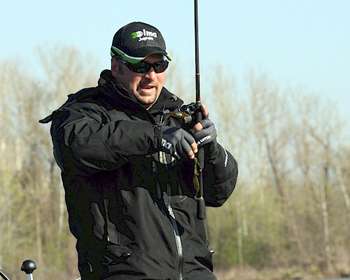
During spring, one of the most popular color patterns is crawfish. Browse through any tackle store and you'll quickly notice that there are dozens of different shades of crawfish imitating baits. It seems like a little overkill. After all, a crawfish is a crawfish, right?
Not necessarily, according to Elite Series pro Fred Roumbanis, who says that early season success can hinge on picking the right hue of crawfish-imitating lures. When approaching a new body of water where he knows that bass are keying on bottom dwelling crawfish, the Oklahoma pro will usually start by selecting a dark colored jig or worm.
The idea is to get a few bites before honing in on the details. "Black baits create a silhouette and generally will get a few bites whether it's the right color or not.
After you catch a few fish, if they're feeding on crawfish you'll often see pincers sticking out of the throat of the bass," explains Roumbanis. It is at this point that the on-the-water detective work begins. If he is able to remove the crawfish from the bass' throat without harming the fish, Roumbanis will take careful notice of the minute details in pincer coloration.
"There are hundreds of different types of crawfish, and I've noticed that on different lakes, there are tiny differences in the coloring of the pincers," he says. "That's really the best way to get an accurate idea of what the crawfish in the lake look like."
Roumbanis points out that the bodies of the crawfish are often discolored when pulled from a bass' mouth because the stomach acids have already began to break down the shell but the pincers will maintain the original color. In order to "match the hatch," Roumbanis carries a plethora of markers, dyes, and sprays. "I really like the Spike-It spray in Orange and Pink," he says. "It's just important that you have the necessary colors to match the pincers as close as possible."
Matching his bait to the exact pincer color of the area crawfish paid dividends for Roumbanis several years ago when competing in a tournament on Lake Shasta in Northern California. After catching a lot of small bass in practice, he landed a 4-pound spotted bass with a bright orange crawfish pincer protruding from its mouth. "It looked exactly like a watermelon/orange color," remembers Roumbanis. "The first thing that I did was go straight to the tackle store, where I found a color that matched. I ended up having an awesome tournament."
For the tournament angler who is constantly fishing different lakes, it can be difficult to pinpoint the minor changes in crawfish coloration from one lake to the next.
However, on your home body of water, a little work can go a long way. "It can be helpful to set some crawfish traps and really find out what color they are," says Roumbanis. "If you have the time to do that, you'll be able to get an exact match."
He also looks at water clarity when attempting to match crawfish colors. In water with a green tint, he opts for watermelon. In stained or dirty water, brown and black hues get the nod. "Those are some key elements that will get more bites in the spring," relates Roumbanis.
(Provided by Z3 Media)




